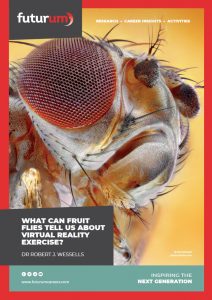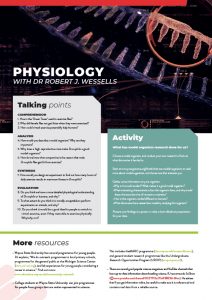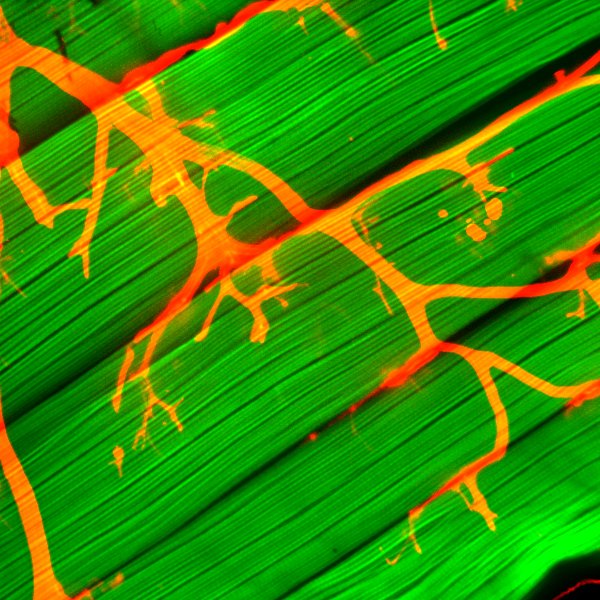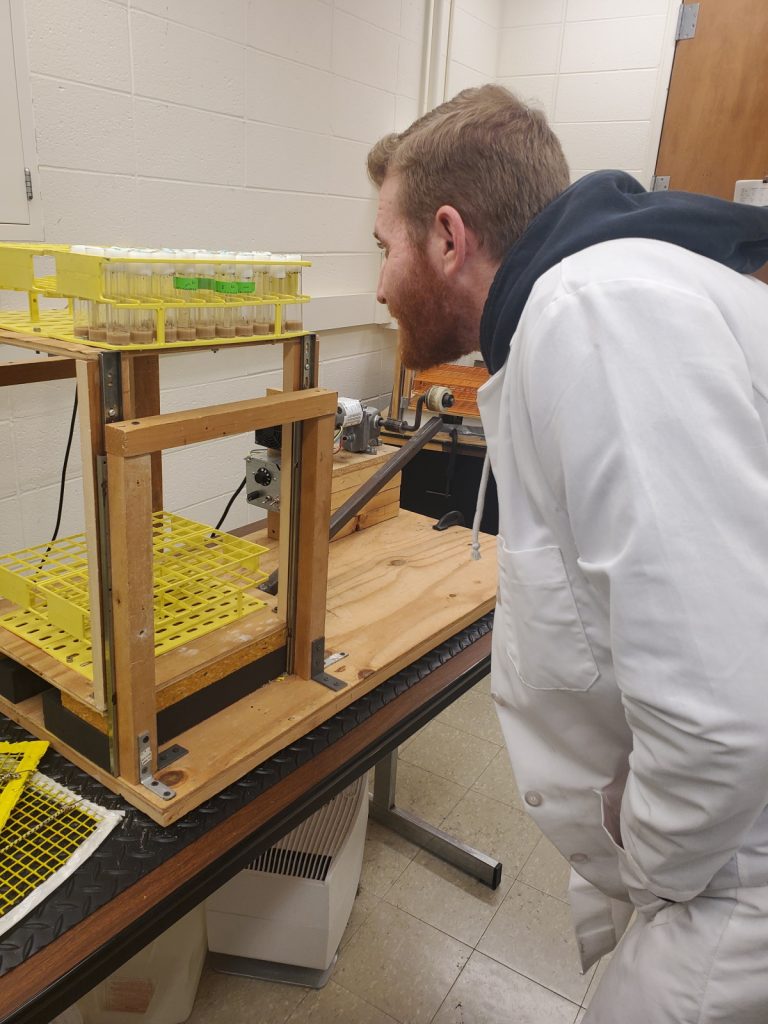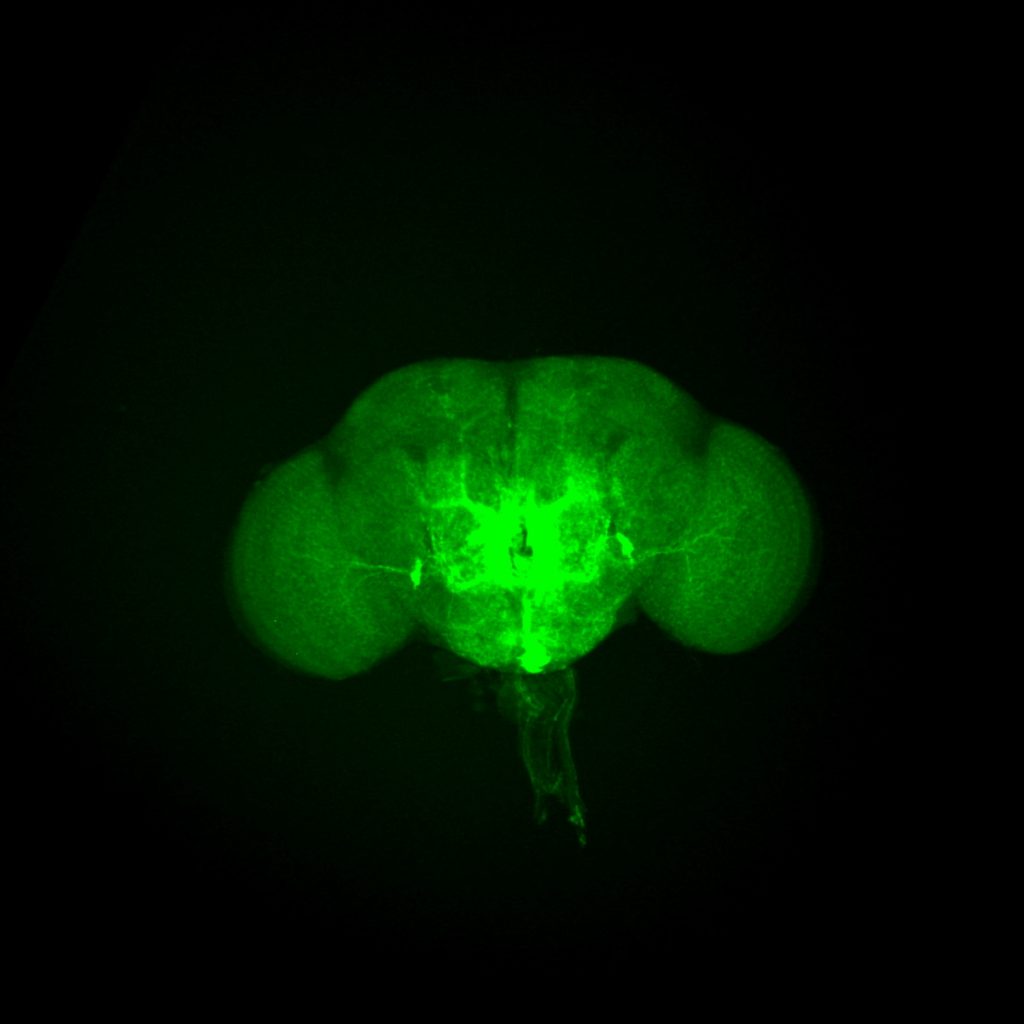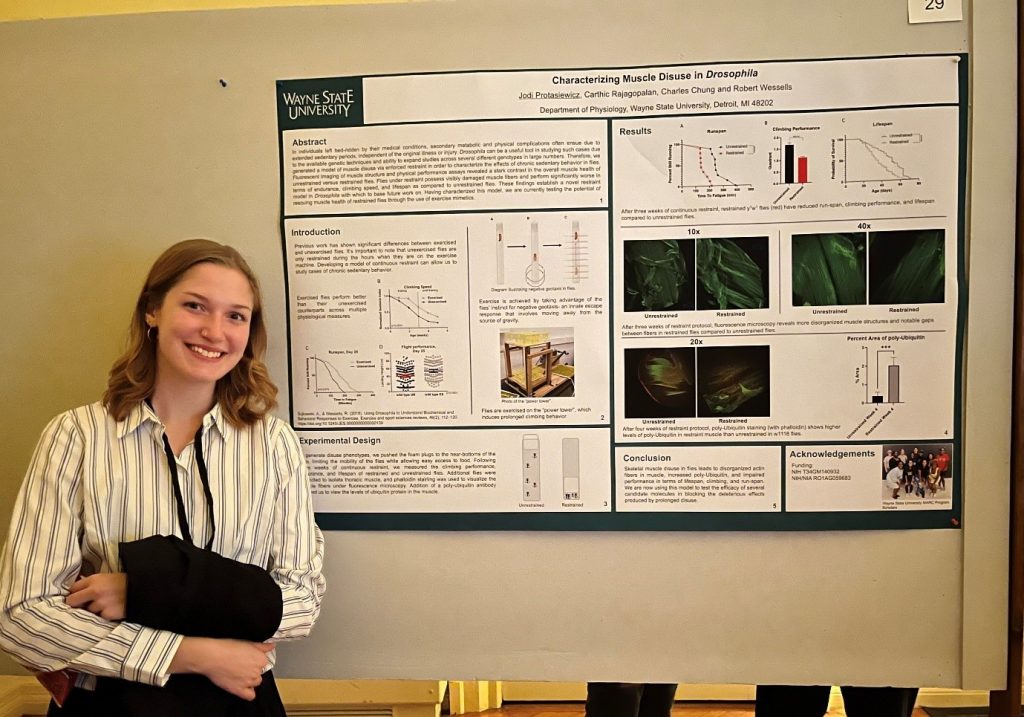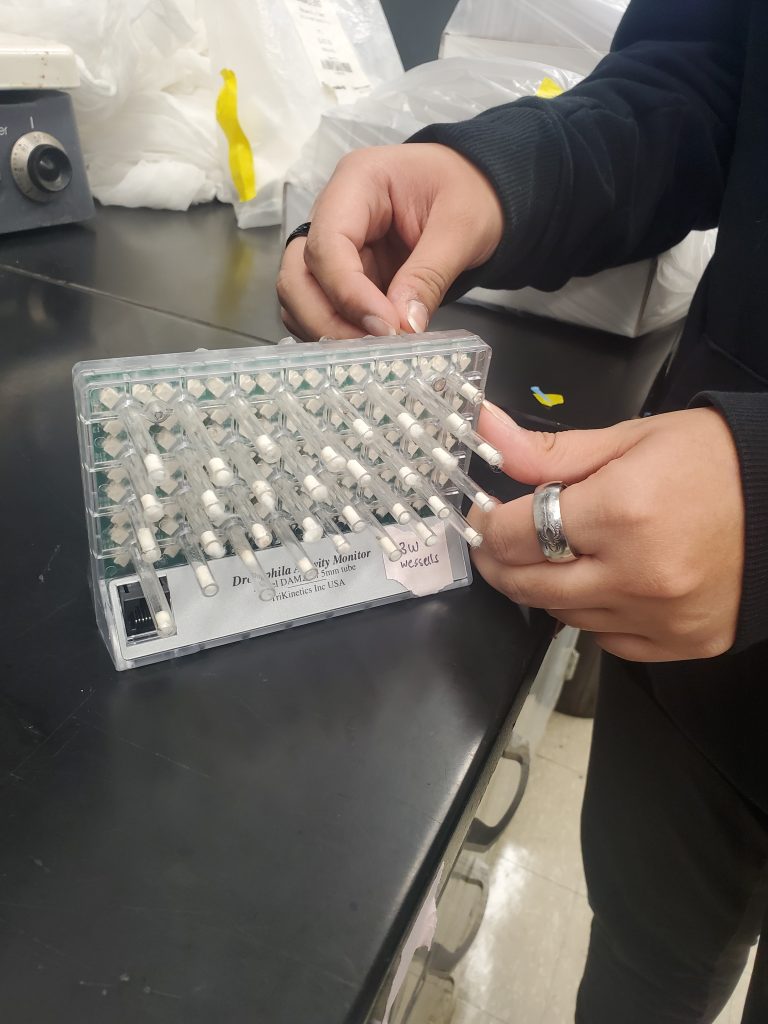What can fruit flies tell us about virtual reality exercise?
Fruit flies can be ‘tricked’ into getting fit without exercising. This discovery by Dr Robert J. Wessells at Wayne State University, in the US, has left him asking if we could do the same in humans.
TALK LIKE A PHYSIOLOGIST
Genome — the complete set of genes in an organism
Reproductive rate — the number of offspring a species produces per unit of time
RNA splicing — a method for editing genes
Model organism — an organism used in medical or scientific research
Neuron — a type of cell found in the brain and nerves that sends and receives signals
Virtual reality (VR) — a computer-generated simulation of an environment that users can interact with
Regular exercise is like a miracle drug. Not only does it ward off the world’s most deadly diseases, including heart disease, cancer, Alzheimer’s and diabetes, but it also slows down the effects of ageing. Imagine you have an illness or injury that makes it impossible to exercise. Losing access to the ‘miracle drug’ and its benefits will only make things worse. But could there be a way to bypass the system and keep fit without actually moving?
Dr Robert J. (RJ) Wessells, a physiologist at Wayne State University, recently discovered how to bypass exercise in tiny fruit flies. By stimulating a certain part of their brains, RJ bred flies that could run just as far as those who had undergone a rigorous training regime. If the link between the brain and exercise is also strong in humans, RJ suggests that we could use virtual reality (VR) to ‘trick’ our bodies into getting fit.
How do you exercise a fruit fly?
The fruit fly Drosophila is a star in biomedical research. Thanks to its high reproductive rate, short life cycle, relatively simple genome and a bit of luck, Drosophila has featured in thousands of experiments and five Nobel prizes over the last century. Although this model organism is just a few millimetres long, it shares around 60% of its genes with humans, meaning it can help us to understand our own biology and develop new medical treatments.
To explore how Drosophila responds to exercise, RJ built the Power Tower – a climbing gym for flies named after a theme park ride. The Power Tower ride hoists people to the top of a 91 m tower before dropping them straight back down again. In RJ’s version, the flies are raised and dropped by a few centimetres, but instead of being strapped in, the flies are inside small tubes.
When they are dropped, the flies fall to the bottom of the tube but instinctively start running up the sides as fast as they can. The Power Tower drops them every 15 seconds, meaning they are knocked back down soon after reaching the top, or even before they reach it. Some flies – the control group – are kept in tubes with the lid pushed right down so that they cannot climb up the sides. After a three-week training routine, RJ can test the speed and endurance of the exercised flies compared to the control group.
Why did female flies not get fitter?
The first results from the Power Tower were curious: male flies got much fitter through the exercise, but females did not benefit. To find out why, RJ used the fact that Drosophila cells can be switched between male and female through changing expression of a female-specific RNA splicing gene that drives female-specific gene expression. By changing the sex of different parts of the flies, he investigated exactly what was causing the male flies to get fitter.
It turned out that the difference was down to a particular set of neurons. When the sex of just these neurons was switched, female flies could increase their fitness through exercise, while male flies lost this ability. RJ had pinpointed the cells that were providing the benefits of exercise, but what is more, he knew how: these neurons were releasing a chemical called octopamine.
What difference does octopamine make?
The next step for RJ and his lab team was to double check their finding by feeding female flies octopamine. Sure enough, the chemical allowed the females to get fitter from exercise in just the same way as males, but there was also an unexpected result.
“What surprised us was that octopamine caused improvements to speed and endurance even in flies that never actually performed the exercise!” explains RJ. Furthermore, flies that had both octopamine and exercise did not get any fitter than those that had one or the other. This was a strong suggestion that the benefits of exercise were being delivered through octopamine itself.
Finally, the researchers showed that the benefits could be delivered in a more natural way from the flies’ brains. They did this by artificially activating the neurons that release octopamine for the same amount of time that they would have spent exercising on the Power Tower. The flies with the activated neurons got the same boost to fitness as those that did the exercise programme.
What does this mean for humans?
In RJ’s experiments, it was as if thinking about exercise was as good as exercising itself, suggesting a strong connection between sensory input to the brain and exercise. The challenge now is to find a safe way of ‘tricking’ the brain into an exercise response in animals or people who are not exercising. “This is exciting as it could potentially help a lot of people who are getting health problems from not being able to exercise,” says RJ. He has already started testing if virtual exercise using virtual reality (VR) could be used as a treatment.
If you have ever used VR, you might think this sounds far-fetched. Surely anyone would know they were wearing a headset and not really going for a run? However, think about what happens when you go to see a scary film at the cinema: your body’s natural fear responses, such as a quicker pulse and sweat, appear even though you know it is just a film. In the same way, RJ hopes that virtual exercise could trigger the responses that keep you fit and healthy when you exercise.
Reference
https://doi.org/10.33424/FUTURUM354
Maryam puts flies into an individual activity monitor.
All images: RJ Wessells
RJ feels his work shows the importance of pursuing a wide range of scientific research. He explains, “It taught me that even questions with no obvious relevance to humans sometimes generate unexpected results that end up changing medicine. Starting with a simple research project about exercise in fruit flies, we were led to a discovery that could have a real impact on human health around the world.”
 Dr Robert J. Wessells
Dr Robert J. Wessells
Associate Professor, School of Medicine, Wayne State University, USA
Field of research: Physiology
Research project: Investigating the links between exercise and the brain through experiments with fruit flies
Funders: US National Institutes of Health (NIH): National Institute on Ageing (NIA), National Institute of Neurological Disorders and Stroke (NINDS)
ABOUT PHYSIOLOGY
If life is a complex machine, physiologists are the mechanics trying to understand how it is built and how it works. They are driven by a curiosity for the details. For example, it was not enough for RJ to see that octopamine could increase the fitness of fruit flies; he kept doing more experiments to confirm if this was really the chemical released during exercise. From the scale of cells and molecules up to whole organisms and ecosystems, physiology aims to stitch together a complete picture of plant, animal and human bodies, ultimately leading to new medical and veterinary treatments.
What is challenging about experiments in physiology?
To focus on a single biological process, physiologists need to try and control all the variables that might affect it when they do experiments. For example, in RJ’s work with Drosophila, he made sure all the flies experienced the repeated dropping of the Power Tower, whether they were exercising or not. Furthermore, he strictly controlled their temperature, diet and even the amount of exercise the flies’ parents had.
What will the next generation of physiologists explore?
“A major area of opportunity will be using small genetic model animals,” says RJ. Including worms, mice, rats and zebrafish among others, these model animals have already led to huge advances in our understanding of development and genetic diseases. It was only recently, however, that physiologists started using them to explore things such as ageing, exercise and metabolism.
The greatest mysteries of physiology lie in the brain, but recent technology is transforming our ability to investigate this organ. Magnetic resonance imaging (MRI) provides 3D images of brain activity, and scientists are now able to stimulate specific neurons and measure the response.
Pathway from school to physiology
• At school and post-16, start by studying maths and science subjects and getting involved with any other STEM opportunities that come your way.
• You can go straight from (post-16) school/college to an undergraduate degree in physiology. To work in research, you will eventually need to do a PhD.
• Other routes into physiology can start with broader degrees such as biology, biomedical science and even other physical sciences or computer science.
Explore careers in physiology
• Watch a video introducing the field by The Physiological Society.
• What can Greenland sharks teach us about living a long life? How does your body know when to take another breath? Explore a blog by the American Physiological Society and learn about the range of research taking place in the field.
• Physiologists work in healthcare, teaching, sport and industry, as well as research. Meet some of them here.
Meet RJ
Who or what inspired you to become a scientist?
I was originally inspired by books and TV shows about animals. I was constantly reading about animals and their adaptations used to survive in environments around the globe. I studied zoology with the goal of studying animal behaviour. I was fascinated by genetics and decided to learn more about how animal behaviours were controlled at the molecular level.
What led you to pursue physiology?
After a PhD in genetics, I became interested in physiology while studying a mutation that affected heart performance. I had to learn about cardiac physiology and figure out ways to measure it in flies. This started me on a new path, thinking about organ physiology and using a combination of genetics and cell biology.
The biggest eureka moment in my career came when my team realised we could do controlled exercise training with fruit flies. We saw a world of opportunity, and how we could someday provide the benefits of exercise to people who can’t exercise for any reason. My colleagues in the lab are still working every day to build on that eureka moment!
RJ’s top tips
1. Don’t give up. There are always setbacks along the way, but if you keep working hard, you can
make it to a career in science.
2. Make good use of mentors – people you know from early on who can give you advice and write reference letters for you.
3. To discuss career paths or do some volunteering, don’t be afraid to contact local scientists at universities or in industry.
 Jodi Protasiewicz
Jodi Protasiewicz
Student on the Maximizing Access to Research Careers (MARC) programme, School of Medicine, Wayne State University, USA
Field of research: Biological Sciences
Funders: National Institutes of Health (NIH), National Institute on Ageing (NIA)
Science was always my favourite subject throughout middle and high school, and I knew that I wanted to involve myself more in science when I started college. Participating in the pre-MARC and now the MARC programme has been a great opportunity for me to get involved, as it has allowed me to join a lab and conduct my own research.
During the school year, I work in my research lab during free time or in between classes. I work full-time in the lab during the summer and have very flexible hours.
The programme has challenged me with learning hands-on skills used in the lab. In my lab, these skills include working with fruit flies as a model organism, interpreting data and making measurements of various things.
I am so happy to be part of the MARC community! It means that I am part of an amazing and supportive group of people, while also preparing me for graduate school. Highlights include presenting my research at conferences and being able to connect with other students who are also passionate about STEM.
In the future, I plan on attending graduate school to earn my PhD. I wish to stay in research afterwards, with my dream career being a position at NASA where I can conduct work in astrobiology.
Actively seek out opportunities, build a network, find a good balance between your research and college classes, and don’t be afraid to challenge yourself!
 Maryam Safdar
Maryam Safdar
MD/PhD Student and Research Assistant School of Medicine, Wayne State University, USA
Field of research: Physiology
Research project: Investigating relationships between endurance exercise and sleep
Funder: US National Institutes of Health (NIH)
Discoveries in biomedical research make up the basis of medical advancement, so I have always had an interest in how those discoveries are made. I took a biology course in high school and was introduced to the concept of super bugs, and that is when my interest in scientific research became something beyond intrigue.
Becoming a doctor – treating disease and working with patients – has been a dream of mine for a long time. I did my undergraduate thesis work in Dr Wessell’s lab and he introduced me to the Wayne State University School of Medicine MD/PhD dual degree programme. This programme allowed me to continue to pursue research, while also getting the education I need to become a doctor.
I was ecstatic when I heard back about my acceptance onto the MD/PhD programme. During the two years of my medical education, I did a few rotations, including one with Dr Wessell. I returned to his lab to continue my education in physiology and to learn about what goes into scientific research.
Making exercise more accessible to those who really need it is one of my main motivators. My project investigates the relationship between endurance exercise and circadian rhythm (sleep) disturbances. I generate the data through experiments and organise it into presentations. However, it is also a lot about learning about the field and how to conduct research. Part of my responsibility as a scientist is to share my findings with others by presenting at conferences and writing research articles.
The best way to assess whether you are fit for your dream career is to try it out! Don’t hesitate to search out opportunities, and put yourself out there to get experience in shadowing or volunteer work.
Write it in the comments box below and RJ, Jodi or Maryam will get back to you. (Remember, researchers are very busy people, so you may have to wait a few days.)

